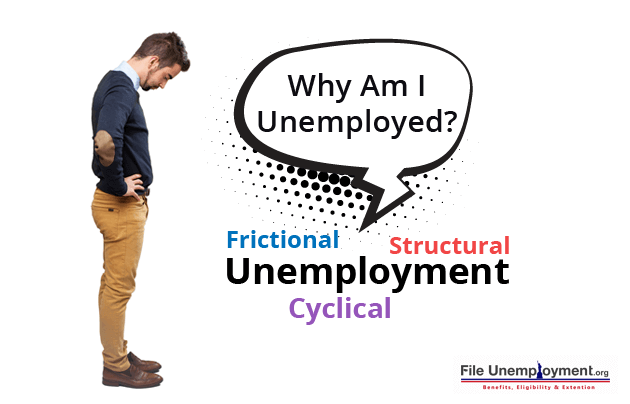An unemployed youth is one who does not have a job, but actively seeks for one based on their educational qualifications. The United Nations categorizes a person as unemployed on the basis of one who is qualified, willing and able to work, but does not find any job based on their specialization.
According to the United States Bureau of Labor Statistics, the unemployment rates among persons between 16-24 years stood at 9.9% in February 2017 and 8.8% in May, 2017. However, there was a gradual drop in youth unemployment that stood at 9% in February, 2018.
Causes For Youth Unemployment

1. Frictional Unemployment
Frictional unemployment happens when workers leave their jobs to find new ones. In most cases, it is a voluntary decision which can result in layoff or termination of the employee. Here, the word friction is referred to the time, effort and expense that a worker takes to find a new job. It is unavoidable because it is integral to a job search process.
Reasons for Frictional Unemployment
- Some unemployed persons have saved enough money and quit their job due to having enough financial resources to keep them afloat.
- When new workers enter the workforce
- When job-seekers re-enter the workforce. These are people who went through a period in their lives when they decided to stop looking for jobs. There could be multiple reasons for a person to quit a job. Some cases include raising children, getting married and taking care of the elderly.
Frictional unemployment can be reduced by bringing better information about jobs to the workers. In a booming economy, usually jobs are in a higher supply. Often employers have a hard time finding qualified candidates. In the expansion phase of the business cycle, workers feel more confident to quit their job in search of a better one.
2. Structural Unemployment
Structural unemployment is a form of unemployment that is generally caused by a mismatch between the skills that workers in the economy can offer and the skills demanded by employers. It usually occurs due to technological changes that make the job skills of workers outdated. Structural unemployment happens due to non-tailored education to fit individuals to the labor market. As a result young people find it hard to find jobs according to their specialization.
Reasons For Structural Unemployment
- Advancements in new technologies, may cause a decline in existing industries. This could be based on using robots and advanced technology that minimizes jobs
- Another reason for structural unemployment, is that it can be highly evident in a place where there are technically advanced jobs available, but the workers lack the skills to perform them
3. Cyclical Unemployment
Cyclical unemployment occurs only when workers lose their jobs because of down turns on the business cycle. It is generally considered to be the major cause of high unemployment. Unemployment gradually recovers from the recession and soon the unemployed have more chances of getting hired. Cyclical unemployment is temporary depending on the degree of recession or depression in a country. Review your unemployment eligibility with our Eligibility Calculator.
Reasons For Cyclical Unemployment
- Cyclical unemployment results from a large drop in demand. It usually starts when a consumer demand for goods and services drop, business revenues decline, etc. Once companies are affected by such problems, workers are given layoffs.
- Cyclical unemployment occurs when there is not enough demand for goods and services in the economy at large to provide jobs.
How To Curb Youth Unemployment In America?
Student Exposure On Industry Needs
Ensure that university students are exposed to industry needs and the current labor market. This will help them find careers that suit their interests while making the best use of their skills. Students who have this exposure will be able to explore several career options during college through internships, apprenticeship, job shadowing, and classroom-based community projects.
With the evolving nature of industries, the market labor requirements also changes. Universities must keep up to this changing trend by altering the academic curriculum and look at how it will cater to various industrial requirements.
Thus, the academic curriculum must be revised and focused towards the practicality of industrial standards. The immense reliance over classroom methodology and theory extincts students from a practical formula of knowing how to progress in an industry.
Post Secondary Partnerships By Colleges
Some universities and colleges in the US have started to provide students with real-world applications and work environments. One such example is Oregon University’s Sustainable Cities initiative.
Here, university students have to partner with business leaders and local government officials to create a business plan and solution to real problems in the line of sustainable cities, transportation, infrastructure and city planning. This initiative exposes students to a practical level of industrial requirements and makes them ready for the job without undergoing any industrial training.
Industry Skills And Programs For Students
Programs that are aimed to focus on industry standards, based on innovative practices to connect students to employers, before they get a job will drive them to a practical forefront.
A university or college that responds quickly to industry needs will not just attract individuals seeking for an employment, but will also attract companies looking for professional development opportunities for their employees.
For example, companies like Modern Technology Council and General Assembly collaborate and work with students after they have completed their formal education. This is an exercise to help them improve their skills needed to be ready to enter into the industry of their choice.
Training For Workforce Demands By Colleges
Companies tie up with colleges and universities to provide recruiting requirements and in due course of time, the university trains students on basis of industry curriculum. This type of an academic progress will help update and revise educational syllabus to suit it to industrial standards.
History Behind Youth Unemployment In US
The United States government began tracking unemployment officially in the 1950s, but estimates before the 1950s was assessed. The Great Depression of the the early 1930s had an employment rate of 23.6% which is considered the highest till date. The country’s lowest rate was 1.2% in 1944 during World War II, where the economy was over driven. The lowest rate of unemployment seen in the United States post World War II was 2.9% in 1953.
In total, the United States has witnessed 11 recessions since 1948 (Postwar period). During the 1980s, the unemployment rate reached a peak of 10.8% and then fell to 5.3% at the end of President Ronald Reagan’s second term. In 1992, it again rose to 7.5% under George H.W. Bush.
The Great Recession pushed it above 10% and stayed above 8% until September, 2012. Some economists state that, the proposal of the American Jobs Act by President Barack Obama, if enacted, would have brought the rate of unemployment below 7%.
Solve Your Unemployment Woes with File Unemployment
Since the job market has been steady, look at boom-towns and other options to help define you grow your career. If you are still unemployed and willing to work then you should use the Benefits Calculator. Read about the the base period and the qualifying wages and the duration of receiving benefits and the amount of weekly benefits based on your state. We’re all ears to listen to your queries on American unemployment and you can share your suggestions in the comment section.


